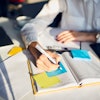
NEW YORK (Reuters Health), Oct 29 - Chronic major depression may result in loss of gray matter in various brain regions, according to a report in the October issue of the Archives of General Psychiatry.
"Major depression should be recognized and treated as early as possible, in order to avoid chronicity or, in turn, later brain changes," Dr. Thomas S. Frodl from Ludwig Maximilians University of Munich, Germany, told Reuters Health.
Frodl and colleagues compared baseline and three-year follow-up gray matter density (GMD) findings, using high resolution MRI, in 38 inpatients with major depression versus those in healthy control subjects to examine whether depression results in further declines in GMD.
Over the three-year study, the authors report, patients with major depression showed significant GMD reductions within the dorsomedial prefrontal cortex, anterior cingulum, hippocampus, dorsolateral prefrontal cortex, and orbitofrontal cortex, as well as in other areas of the frontal, temporal, parietal, and occipital cortices and the cerebellum.
Similar changes were not seen among healthy controls, who nevertheless experienced some GMD decline bilaterally within the superior and inferior orbitofrontal cortices, the gyrus rectus, and some regions of the cerebellum.
The GMD reductions in the hippocampus, anterior cingulum, left amygdala, and right dorsomedial prefrontal cortex in the depressed patients were significantly greater than in controls.
Patients who experienced stable remission during this period showed significantly less GMD decline than nonremitted patients, the researchers note.
"Our findings indicate that during depressive episodes GMD diminishes in limbic and frontal cortical brain regions, including neuroplastic changes due to the effect of depression," the investigators conclude. "More severe neuromorphological abnormalities ... seem to be clinically associated with a more severe outcome of depression."
"Up to now, the origin of these changes is not known," Frodl said. "These could be neuroplastic changes, but also changes in the number of neurons. These things have to be investigated further."
By Will Boggs, MD
Arch Gen Psychiatry 2008;65:1156-1165.
Last Updated: 2008-10-28 17:43:57 -0400 (Reuters Health)
Related Reading
White-matter microstructural abnormalities linked to late-life depression, January 27, 2006
Copyright © 2008 Reuters Limited. All rights reserved. Republication or redistribution of Reuters content, including by framing or similar means, is expressly prohibited without the prior written consent of Reuters. Reuters shall not be liable for any errors or delays in the content, or for any actions taken in reliance thereon. Reuters and the Reuters sphere logo are registered trademarks and trademarks of the Reuters group of companies around the world.

















